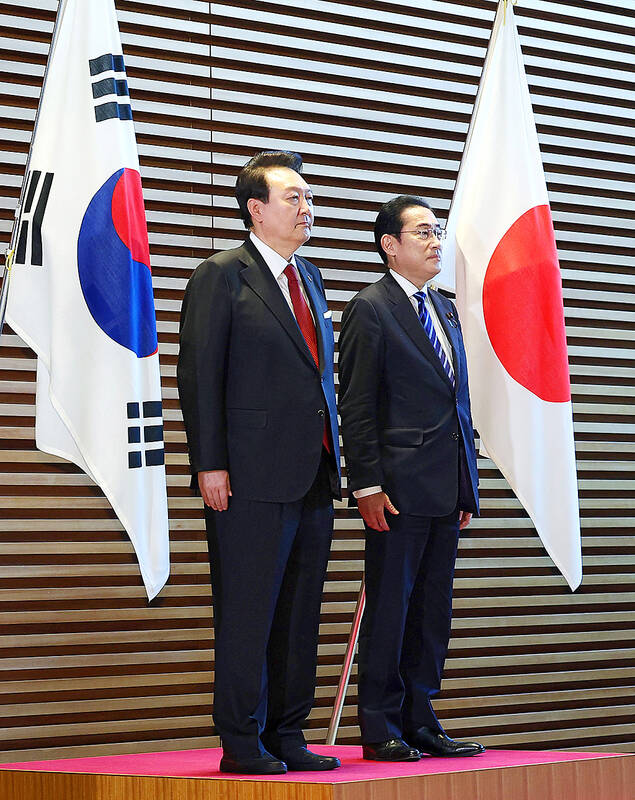Nearly everything about South Korean President Yoon Suk-yeol’s first summit with Japanese Prime Minister Fumio Kishida in Tokyo will be scrutinized for signs of warmer bilateral ties, including a shared meal of a Tokyo classic called omurice.
The dish, whose name is a mash-up of omelet and rice, has become the talk of the town since Japan’s Fuji TV reported on Monday of a hushed plan for Kishida to treat Yoon at Rengatei, the storied but no-frills restaurant that invented it.
Yoon, a self-described foodie and avid cook, reportedly had “unforgettable” memories of the omurice he ate in his youth at the 128-year-old establishment in Tokyo’s Ginza district. He made frequent trips to the Japanese capital in 1966 while his father, a university professor, spent a year there, he told the Yomiuri daily.

Photo: EPA-EFE
Japanese and South Korean officials have declined to confirm the plan or venue, while Rengatei, famed as the birthplace of omurice in 1900, declined to comment.
Although many foreigners might associate Japanese cuisine with sushi or tempura, yoshoku, or Western-influenced dishes such as omurice and tonkatsu (deep-fried pork cutlet), are more common fare on Japanese dinner tables.
Yoshoku is a genre of Japanese cuisine established more than a century ago, and some made its way to South Korea in the 1960s as ethnic Koreans traveled between the two countries, said Motoo Kawabata, a professor at Kwansei Gakuin University who specializes in Japanese restaurants’ global strategy.
Kishida and Yoon will reportedly share a more formal dinner of sukiyaki beforehand, but the real ice-breaker could be when they sit down for omurice, Kawabata said. Japan and South Korea are holding a summit for the first time in 12 years, seeking to mend relations that had deteriorated severely.
“It could be an effort to foster a laid-back mood, through a casual dish that both Japanese and Koreans consider comfort food,” he said.
Rengatei’s price for its omurice: 2,600 yen (US$19.57).
Kawabata said the omurice in South Korea typically has a thinner and firmer layer of eggs, while the image of a perfectly crafted one in Japan has a fluffy, runny, almond-shaped covering of eggs that blanket the ketchup-fried rice.
“Yoon may have been impressed with the softness of Japanese-style omurice,” Kawabata said.
Although Rengatei’s original dish mixed the egg batter in with the rice, the omurice as Japanese people know it today was conceived for and popularized in the 1985 Juzo Itami film Tampopo, a critically acclaimed meditation on food and one of Japan’s best known movies.
Hiroshi Modegi, the third-generation owner chef of Taimeiken, which appears in the film, said he was disappointed that his restaurant was not the president’s choice, but welcomed the renewed attention on omurice.
“I hope the world discovers that Japanese food culture also has a dish like this,” he said.

On April 26, The Lancet published a letter from two doctors at Taichung-based China Medical University Hospital (CMUH) warning that “Taiwan’s Health Care System is on the Brink of Collapse.” The authors said that “Years of policy inaction and mismanagement of resources have led to the National Health Insurance system operating under unsustainable conditions.” The pushback was immediate. Errors in the paper were quickly identified and publicized, to discredit the authors (the hospital apologized). CNA reported that CMUH said the letter described Taiwan in 2021 as having 62 nurses per 10,000 people, when the correct number was 78 nurses per 10,000

As we live longer, our risk of cognitive impairment is increasing. How can we delay the onset of symptoms? Do we have to give up every indulgence or can small changes make a difference? We asked neurologists for tips on how to keep our brains healthy for life. TAKE CARE OF YOUR HEALTH “All of the sensible things that apply to bodily health apply to brain health,” says Suzanne O’Sullivan, a consultant in neurology at the National Hospital for Neurology and Neurosurgery in London, and the author of The Age of Diagnosis. “When you’re 20, you can get away with absolute

May 5 to May 11 What started out as friction between Taiwanese students at Taichung First High School and a Japanese head cook escalated dramatically over the first two weeks of May 1927. It began on April 30 when the cook’s wife knew that lotus starch used in that night’s dinner had rat feces in it, but failed to inform staff until the meal was already prepared. The students believed that her silence was intentional, and filed a complaint. The school’s Japanese administrators sided with the cook’s family, dismissing the students as troublemakers and clamping down on their freedoms — with

As Donald Trump’s executive order in March led to the shuttering of Voice of America (VOA) — the global broadcaster whose roots date back to the fight against Nazi propaganda — he quickly attracted support from figures not used to aligning themselves with any US administration. Trump had ordered the US Agency for Global Media, the federal agency that funds VOA and other groups promoting independent journalism overseas, to be “eliminated to the maximum extent consistent with applicable law.” The decision suddenly halted programming in 49 languages to more than 425 million people. In Moscow, Margarita Simonyan, the hardline editor-in-chief of the